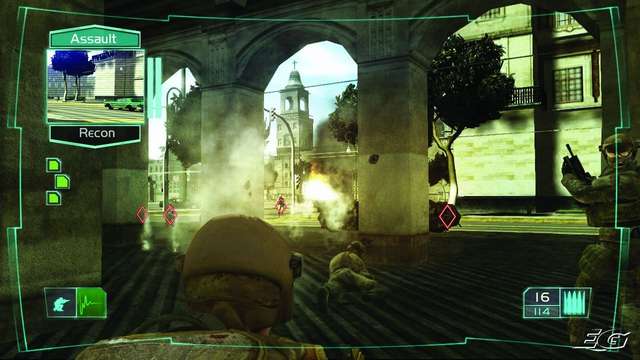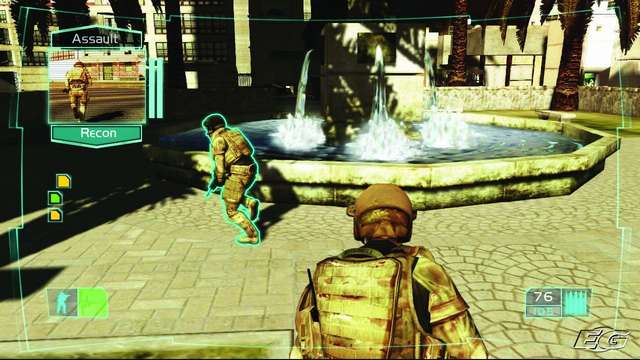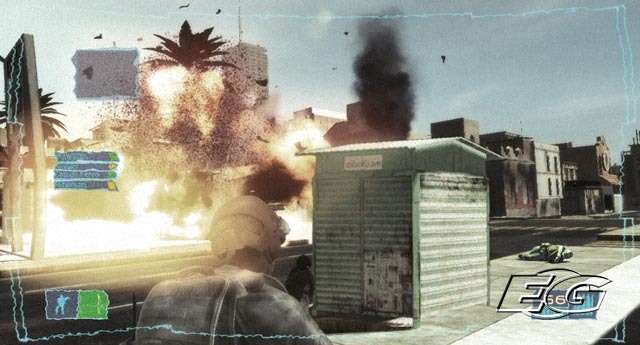Ghost Recon: Advanced Warfighter
Happiness in magazines.
Much like Elder Scrolls: Oblivion, the absence of Ghost Recon Advanced Warfighter from the 360's launch line-up was a regrettable one. As one of the undoubted stars of X05, it looked for all the world like Ubisoft had finally done enough to propel the brand into the big league for the first time, after years in the shadows of its other Tom Clancy titles. No wonder people wept at the four month delay.
But never mind about that; we'd always much rather play a 'finished' version than some rush job drop kicked out of the door just to cash in on the launch frenzy and appease shareholders. Just as we hoped all along, the chance to savour a more rounded, polished version of the third in the action strategy series seems like a much better idea - especially now people can actually walk into a shop and buy a 360 without going on a mile long waiting list.
Sticking broadly to Red Storm's excellent formula, GRAW is once again a squad-based shooter (in 'over the shoulder' third- or first-person, the choice is yours) all about 'near future' warfare and kicking the butt of some nefarious megalomaniac and a posse of foolishly loyal insurgents. Being set in 2013 in Mexico, it gives Ubi full license to throw in a few obligatory 'weapons of the future' to add to the otherwise standard load-out that accompanies each 'ghost'. In this instance Scott Mitchell and his merry band come equipped with the IWS, or Integrated War System, combining satellite comms, 'enhanced survivability', and the odd new weapon thrown in for good measure.
In plain English, the effect that all this new technology has had on the gameplay is somewhat more pronounced than previous efforts, and in the main each addition improves things in subtle ways. For a start, you now call up a tactical map at any time (back button) and issue basic move and fire commands to your units without physically having to shepherd them around the map. This comes in especially useful when you can call on the services of the AUV, a mini flying-saucer-style eye-in-the-sky recon unit that you can direct wherever you want in order to scout ahead and see who's lurking where. With visible enemy units pinpointed, you can then direct ghost units ahead in the knowledge of where the imminent threats are, and get them to target specific areas in a slick, intuitive fashion.

While this might sound dangerous (and sometimes it is if you leave them too exposed), you also get the occasional use of a tank or an attack chopper with which to scout ahead and cause general mayhem. Needless to say, the enemy's still more than capable of dealing with anything you throw at them, but the new options available to you lend a new dimension to the combat, and make it feel a little less like a four-man killing machine, and more of the hi-tech war effort. For the first time ever, Ghost Recon feels a much more unique game, rather than just an outdoor Rainbow Six.
In addition to the new tactical map and commands is the new 'picture-in-picture' view that's permanently displayed in the top-left of the screen, showing what your other units (tank, AUV or squad members) can see at any given point. Admittedly, it's too small to see anything in especially useful detail, but it's great to have a chance to see what's going on - good or bad - from their perspective. With these 'live' transmissions now a standard part of your equipment, you also get beamed TV news bulletins during the game itself, rather than the old-style between-level cut-scenes that used to rather wash over you.
But by far the most immediately impressive 'new' element of GRAW is the overhauled graphics engine. 2004's Xbox effort certainly saw the series take a forward step in visual fidelity, but Ubi has gone all-out this time to make it among the most attractive games ever seen on any system. Using all manner of cutting edge lighting effects (HDR, or high dynamic range, being an obvious favourite new trick) and displaying a truly stunning level of detail, depth, variety and panache, the environments in and around the hot, dusty streets of Mexico City are among the best anyone's pulled off in a game. Truly showing off the benefits of next-generation technology and the immersive qualities of high definition gaming, the vibrancy and atmosphere from creeping around the terror-strewn streets is a hugely impressive sensation. Sure, you get used to it depressingly quickly, but every now and then you'll afford yourself a moment to breathe it all in and feel glad that games finally look as good as you always hoped they would.

Thankfully Ubi hasn't skimped in providing equally convincing character models that move with effortless precision, each blessed with wonderfully natural movement transitions and the kind of animations so incidental you probably won't even notice how good they are - although we're still not convinced it's physically possible to do a sideways roll with a sniper rifle strapped across your back.
One of the most truly impressive new innovations in the game is the way your character interacts with the scenery. In the past, games have always generally insisted that basic commands like peeking around a corner, peeking up from cover or sidling up against a wall warrant their own button, but not in GRAW. Ubi has taken a breathtakingly simple yet intuitive step towards overcoming all of this clunky nonsense by introducing a series of intelligent context-sensitive commands. For example, walking up to a wall now puts you flat against it if you continue to hold the direction for half a second, and once activated you can then automatically peek out from a corner by holding the direction required. If you happen to approach a box or a barrel while crouched, the AI assumes you want to use it as cover and allows you to do the same again: press up and you can peek out from behind.
Even better is how well the fire commands work with this new system: holding the direction peeks you out, but also holding the left trigger puts you in a slightly zoomed-in mode (optional), allowing you to loose off a few rounds with the right trigger, let go and pop back in behind cover. If your target's just a little out of range then you can also click the right stick and zoom in any scoped weapon, click again for 15x zoom, click again to get rid of the zoom entirely and still creep back behind cover. With practice it all works so seamlessly that you have to admire Ubi for refining it so successfully.

As ever, you get to move your squad to wherever you want, simply hitting up on the d-pad to choose a cover point, up again on a chosen target, and all in the knowledge that they'll generally be pretty sensible about wherever they end up. Occasionally they do have a suicidal tendency to stray into your line of fire or expose themselves to enemy bullets when they're stationed at corners, but otherwise they're exceptionally easy to manage, and provide a huge boost whenever they're around.
On the odd occasion when you're forced to tackle missions solo, you certainly notice when your squaddies go AWOL. In fact, the game's already-quite-challenging difficulty level spikes alarmingly during these solo sorties to the extent where the game temporarily stops being anywhere near as much fun.
Part of the issue here is the game's normally wise decision to restrict your health top-ups; sometimes you might get a refill at a handy ammo dispenser, but otherwise that's your lot, and when you're expected to become a one-man army, such design decisions really weigh down your progress. Combined with some unwisely placed checkpoints, you'll be reaching into your pockets to fill up the swear box as the red mist descends after the 20th retry of the same solo section. Towards the middle and towards the end of the 11-mission single-player campaign, GRAW treads a fine line between challenging and annoying, and when it oversteps the mark you're reminded of just how frustrating the series can be when it wants to.


